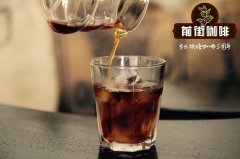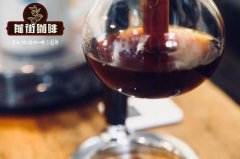Coffee cup test procedure coffee cup water powder ratio coffee cup standard coffee cup test process

Professional coffee knowledge exchange More coffee bean information Please pay attention to coffee workshop (Weixin Official Accounts cafe_style)
Basic coffee cup test steps
Now that you have the coffee cup supply outlined above, you are ready to start making the actual coffee cup. I try to break the whole process down into simple steps; hopefully you can keep up.
If you have any questions about any of these steps, please leave a comment in the comments section below.
1。First measure your whole coffee beans (I recommend 2 grams of coffee and 6.5 ounces of boiling water) and put them into each coffee cup. If you drink a lot of coffee, remember which one is which.
2。Now is a good time to start boiling water, using only fresh filtered water if possible. Otherwise, you may find that the water will contaminate and mask the subtle taste of the coffee.
3 is shown. Now, pick up a cup measuring bowl, grind the coffee with your coffee grinder, and put it back in front of the cup. If you are pouring more than one cup of coffee (which ideally should be the case), make sure to empty the grinder thoroughly, clean the grinder, and brush it clean between each sample.
4 is shown. This is a great opportunity for customers to evaluate and smell the coffee powder before pouring boiling water into the cup.
5。Your kettle should be turned off by now and the water temperature should be at its best (preferably 202F). If your water is still boiling, let it sit for about 25 seconds and pour it out when it comes out of the boiling water.
When you pour coffee, always start where you first ground it and continue in the order you ground it (oldest to newest).
6。Make sure all of the coffee is fully saturated and pour slowly. Remember to keep the exact ratio of water to coffee (2 grams of coffee to 6.5 ounces of boiling water).
An easy way to get to the right amount of water is to do a rehearsal on a glass and mentally note where the water reaches the bowl, just to make sure it reaches that level. Once you've done this a few times, you'll instinctively know when to stop pouring.
7 is shown. Time starts when you start pouring water, so be sure to keep track of the time and use a timer if possible, most smartphones now have built-in apps.
Wait 4 minutes for coffee grounds to settle in each cup.
8。It'll harden! Now it's time to get intimate with your coffee! During the 4 minute wait time, the water and coffee have passed a special moment, and now you will see a thick layer of coffee grounds on your cup.
Get close to your cup (don't be shy) because you're about to do something called "breaking the shell."
Keep your face as close to your cupping bowl as possible, pick up your spoon and slowly begin to break the crust while inhaling all the released aromas.
9。Repeat this process for each coffee cup. Once the crust breaking ritual is complete, it's time to skim off the remaining coffee grounds at the top.
There is no right or wrong way to do this, but usually the experienced person will take two spoons, place them at the back of the bowl, then drag the edges of the spoons forward in a single fluid motion, and then meet again at the front of the cup; then they just dig into the ground.
10。Now it's what you've been waiting for-taste!... But hang in there for a second. Before tasting, turn around the table and sip a spoonful of the sample while gently inhaling.
There's a way to do this madness--the goal is to get your tongue wet with coffee as you inhale, allowing the aroma element to take full effect. If you've ever watched wine tasting, you'll notice that this cup test is similar to that one.
11。After using the spoon, return it to the goblet full of water. This will ensure that the spoon is thoroughly rinsed before you use it again in the next cup measuring bowl.
You should try to avoid any flavor contaminating other batches of coffee (cross-contamination).
12。As the cup begins to cool down, you can savor each cup of coffee in a whole new light. Our goal is to observe the taste of coffee after cooling.
END
Important Notice :
前街咖啡 FrontStreet Coffee has moved to new addredd:
FrontStreet Coffee Address: 315,Donghua East Road,GuangZhou
Tel:020 38364473
- Prev

How to make coffee by hand? how to make coffee by hand? how to make coffee by hand?
Professional coffee knowledge exchange more coffee bean information please follow the coffee workshop (Wechat official account cafe_style) 1. Test new coffee on a variety of brewing equipment when we buy a new coffee, we look at its origin, altitude, processing methods and the roaster's tasting records to determine where we start testing coffee. We always seem to start from Chemex or V.
- Next

Is the Indonesian Kopi Luwak real? introduction to the flavor and taste of Indonesian civet coffee
Professional coffee knowledge exchange more coffee bean information please follow the coffee workshop (Wechat official account cafe_style) Qianjie Indonesian civet coffee brief introduction Kopi Luwak chooses from the civet feces to make Kopi Luwak, produced in Indonesia, Indonesia grows a large number of coffee crops, there are wild animals called civets, omnivores, pointed mouth, dark gray fur. Indonesia
Related
- Beginners will see the "Coffee pull flower" guide!
- What is the difference between ice blog purified milk and ordinary milk coffee?
- Why is the Philippines the largest producer of crops in Liberia?
- For coffee extraction, should the fine powder be retained?
- How does extracted espresso fill pressed powder? How much strength does it take to press the powder?
- How to make jasmine cold extract coffee? Is the jasmine + latte good?
- Will this little toy really make the coffee taste better? How does Lily Drip affect coffee extraction?
- Will the action of slapping the filter cup also affect coffee extraction?
- What's the difference between powder-to-water ratio and powder-to-liquid ratio?
- What is the Ethiopian local species? What does it have to do with Heirloom native species?

